As a SaaS business owner, you want an affordable – yet effective – PR plan.
You know the value of a good PR strategy.
It helps you get media coverage, builds your brand, and attract the potential customer.
However, spending tons of money on hiring a public relations agency is also not an option. When you’re a small SaaS startup, you don’t have that kind of money!
What’s the solution?
In this post, I’ll show you some practical ways to generate PR traction for your SaaS business without shelling out the big bucks.
Here’s what I’ll cover in this post:
- 5 Simple, Yet Effective SaaS PR Strategies
- 3 PR Mistakes To Avoid
- Why your SaaS company needs PR
- Saas PR: Do It Yourself
5 Simple, Yet Effective SaaS PR Strategies
When it comes to SaaS PR, it pays to keep it simple.
You don’t need unparalleled techniques or remarkable innovation. What you need are tried-and-tested PR strategies that you can use when pitching your SaaS company to reporters.
Here are 5 SaaS PR strategies that’ll get you press:
1. Come Up With Data/Insights
As a SaaS company owner, you are sitting on a goldmine of data.
Whether it’s data, you came across while developing your product, or user statistics you’ve found – these are figures that journalists love.
You can use this data to predict industry trends or reveal invaluable insights about your target market that your company gained from its customers.
When you include analytics in your pitch, it’s easier for your media contact to spin a story around those numbers. Data based stories sell better.
Here’s an example of a data-based campaign by Motovo that analyzed more than 300,000 tweets containing 30 common terms like college, church, beer, and sports.
Using this data, Motovo was able to pinpoint which areas and populations most frequently talked about these topics. They then matched up two terms to see which term “won” in each state. In effect, the comparisons showed which parts of the country talked more about money than family, or which areas focused more on sports than girlfriends.
The data-based campaign got featured on Mashable, AV Club, Daily Dot, Bustle, Pixable.
Remember, adding figures and analytics will make their articles:
- More eye-catching to a reader
- More scannable to a target audience
- Easily shareable
- Easier to do follow-up stories as reporters can build on those initial figures with additional data
When you’re making a pitch, take full advantage of that analytics goldmine your startup is sitting on. You need to ensure that your data is useful and relevant to a lot of people.
People process visuals much faster than text.
Journalists get tens of pitches a day and have limited time on their hands to go through them. If you want the data to be picked up by a PR reporter, graphs can be a simple way to make them understand numbers quickly.
The data for the graphs need not be your own, but if it has up-to-date information from reputable sources – it will make your pitch unique.
For example, a study by Addiction-Treatment.com used data from popular celebrity Instagram accounts to find out who posted the most photos. They also categorized it under which celebrities shared the maximum number of pictures with drugs or alcohol.
Here’s the graph they created from the numbers:

The easy-to-digest visual format confirmed that celebrities love to overshare on Instagram, even when they’re doing something illegal or dangerous. This appealed to a wide range of publishers and audiences.
Business Insider used this information to write a post titled: This Chart Shows Which Celebrities Post The Most Pictures On Instagram.
2. Answer Journalist Requests
There is a great quote from Acquire.io about acquiring new customers by being an expert in your niche:
Knowledge is the only thing that gives you the ability to alter a complex problem into the simplest solution. This is what every viewer seeks. Also, it’s the only thing that distinguishes you from the others.
You can put this knowledge to use! You can respond to journalists asking questions and seeking specific Subject Matter Experts for their stories and get featured in press at the same time.
Answer media queries.
Responding to journalist requests is a quick way to acquire media coverage for your brand.
A journalist request is when a reporter requests for information, comment, quote, or answer from an expert on a particular topic or subject. Journalist requests are also known as PR requests or source requests. Usually, these journalist requests are sent using online tools like HARO.
This is what a journalist request looks like on HARO:
Summary: What IT departments need to do when a remote employee is let go
Name: teena.maddox@cbsinteractive.com Maddox TechRepublic
Category: Business and Finance
Email: query-ap81@helpareporter.net
Media Outlet: TechRepublic
Deadline: 12:00 PM EST – 24 April
Query:
Advice on what IT departments need to do when an employee is
fired and they’re a remote employee – especially during the
pandemic. Everything from how to get their laptop back, to how
to secure their email, etc.
HARO or Help A Reporter Out is a popular sourcing tool that enables journalists to connect with relevant expert sources. It not only helps journalists’ meet demanding deadlines but also permits brands to tell their stories.
When you sign up for HARO (help a reporter out), you get daily emails containing lists of journalists and what they need.
For example, if you were a career coach, you could respond to this query and get some media coverage on Fast Company:
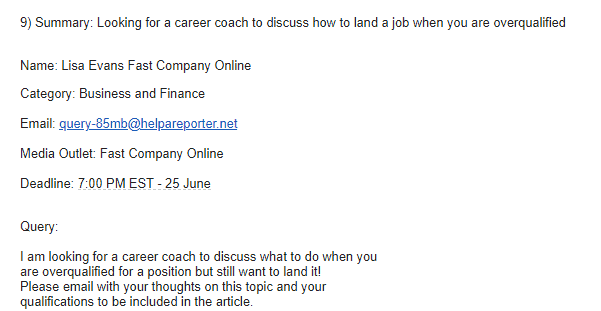
If you match the requirements in their inquiries, you can shoot an email to the reporter with your quote.
If you work in the business/finance or high-tech fields, you can usually find dozens of suitable queries every week. Answering them usually takes under 10 minutes – not a bad return for a feature in a top publication.
The one major downside in HARO is its inadequate search feature. To find relevant service requests, you need to sift through tons of media opportunities.
To find relevant journalist requests quickly and efficiently, you can use JustReachOut.
Here’s an example of a media opportunity on JustReachOut:
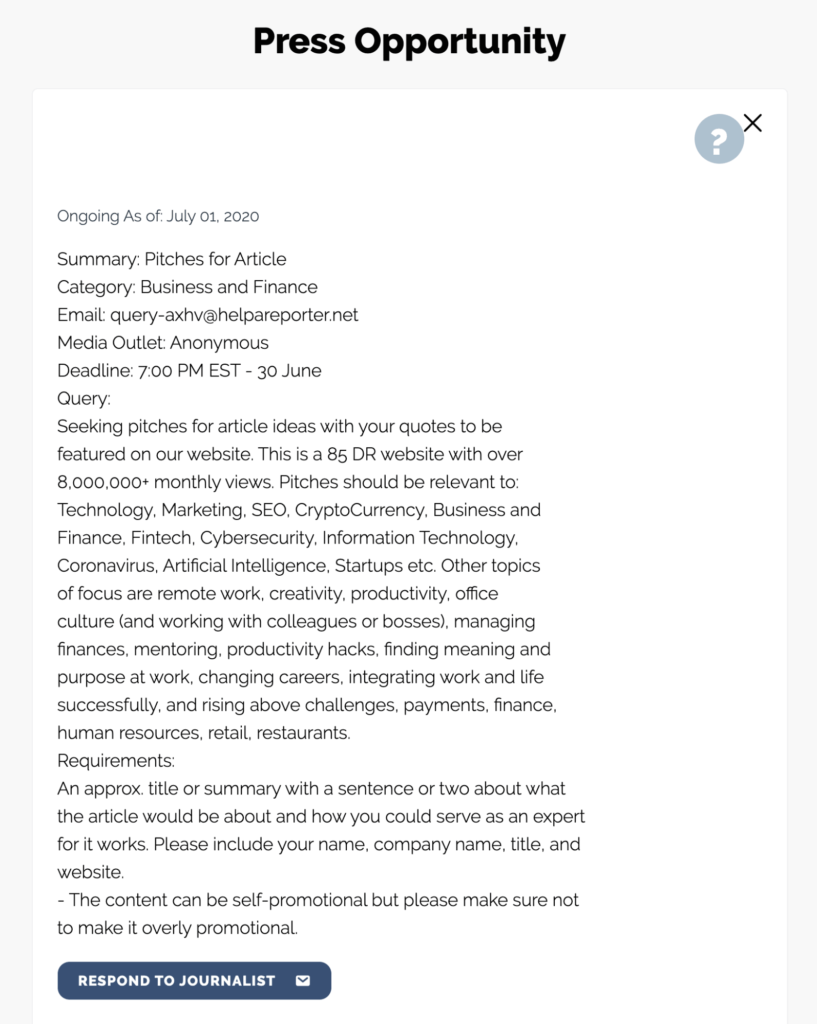
With JRO, all you need to do is type your topic, and the tool will find media queries that are closely related to your topic of interest. Next to each opportunity is a button that allows you to ‘respond’ immediately to that query.
The software monitors daily press opportunities posted on most of the top journalist request platforms such as ProfNet, SourceBottle, ResponseSource, Reddit, and Quora to identify the relevant ones for your business.
This video shows how our journalist request and outreach feature works:
When you respond to a media request, you help a journalist find what they need.
Even if your quote is not used for a particular story, this is the start of your media relations. The reporter now knows that you are an expert in the field they regularly write about, and they will approach you for future stories.
Moreover, a reporter seeking a quote from an expert source is already working on a newsworthy article.
So, you don’t have to spend time trying to find an on-trend angle to your brand story. If the query is relevant to your business or expertise, you can pitch your opinion for any ongoing news story.
The easiest way to ensure that a journalist will include your response in the final story is by demonstrating that your quote will enhance the emotional appeal of the article and illustrate an essential point.
Here’s how one of my clients responded to a media query to get a positive response:
Subject: “How do you use your blog for your business?” inquiry
Hi, Gresham.
Happy Monday!
I came across your inquiry, “How do you use your blog for business?” on JustReachOut.
We’re a small IT business – HelpSquad – located in Pennsylvania. We develop and staff agent-supported live chat customer service tools. Our client base ranges across different industries and locales.
Below is our answer to your inquiry.
<<answer to query>>
I hope this information helps your article. Please let me know if you need any questions. I will be happy to provide anything else you may need. I’m also attaching a headshot of our founder and CEO, Michael Kansky.
Thank you so much!
Takeaways for your SaaS businesses:
- The subject line can be the title of the query. That can get a journalist’s attention very quickly because it is familiar to them and makes the email stand out.
- Get right to the point and establish credibility upfront. State where you saw the request, who are you, what’s your company about, and then quickly move to the response to the query.
- Keep it to 3 small paragraphs before you answer the question.
- Add a short closing sentence in the end with your contact details.
If you want some more templates on how to respond to press opportunities, check out my detailed post on How To Respond to Press Opportunities and Get Featured in Press Weekly.
3. Use Newsjacking
Weave your story into a discussion about a current event in a compelling way. The goal is to find a connection to align your story with what’s viral at the moment.
This content marketing process is called newsjacking, and it is highly effective in making your media pitch more relevant and eye-catching. It also works well for saas marketing.
For example, if something in the technology marketplace goes viral on social media platforms like Twitter, tying your cloud technology business press release to it is a smart way to get traction.
Why is this tactic effective?
Journalists thrive on current events.
They want their stories to be about what’s going on at this moment. Getting your story to align with breaking news is an easy hack that can boost the chances of your SaaS business getting a press mention.
Here’s my example:
I used newsjacking to take a startup from 0 to 40M+ page views before it got acquired by Google.
My goal was to get more users on an opinion sharing app. The problem was, we had 0 users when we got approved on the App Store.
So what did I do?
I found breaking news stories, made a poll for the story, and asked the journalist to embed each poll in the article. The idea was to ask their readers for an opinion on the matter being discussed.
These are the steps I took to reach out to journalists:
Newsjacking Step 1: Made a list of relevant journalists
I used Techmeme to source top reporters and media outlets since I was after breaking news.
Next, I selected a story and made a list of all publications and the reporters and journalists at these publications. This is how my list looked.
Newsjacking Step 2: Wrote a pitch email
My pitch emails were super short. I wanted to show valuable content and make the ask clear. My goal was to do it in 2-3 sentences.
This was the email I sent:
Subject: Got a poll for you: Which Foursquare logo do you prefer?
Hey Chris-
Made a poll for your article asking which Foursquare logo people like the best, check it, might be fun to get your readers more involved to get more to come back to the article: http://polarb.com/polls/194407
Here are how these polls look like live: http://guycodeblog.mtv.com/2014/03/21/vote-favorite-melanie-iglesias-photos/
-Dmitry
The idea is to show or add valuable content to the reporter’s article and interests. Your pitch should relate directly to something they wrote.
Newsjacking Step 3: Found accurate emails of every journalist
Most of the time, the format of an email is either jon@somepublication.com or jsmith@somepublication.com or jon.smith@somepublicaiton.com.
You can also use these tools to find emails:
Journalists prefer to get pitched over the email, rather than a telephone call. So use this medium of communication effectively.
Use JustReachOut to avoid manually searching for the correct email address.
Newsjacking Step 4: Sent pitch emails and tracked the opens
Once I was ready with the email address and the email copy, it was time to pitch.
To track whether a journalist opened my email or not, I used a handy Gmail plugin called YesWare. Depending on the open rates, you can decide if your subject lines are working. I recorded all the open rates and any notes in a spreadsheet.
This information can come in handy to modify subject lines to ensure better open rates. Using the simple email above, I acquired a 50 percent response rate.
Because the polls had high engagement value, relevance, and timeliness, it was a no brainer for reporters to add them into the articles.
This is how the embedded polls looked:
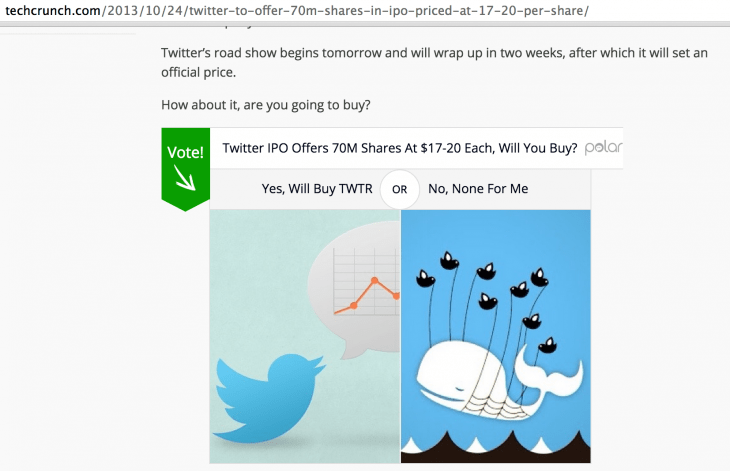
Now, this is important.
Because of the nature of breaking news articles, Polar would get a huge jump in traffic within the first few hours of the article being published. However, this would peter out afterward.
So, we had to continually chase the biggest, hottest tech news with our polls.
When Snapchat turned down $3 Billion from Facebook, we made a poll and got 38,000+ votes in a Mashable article.
When WhatsApp got acquired, we made a poll in a TechCrunch article and got close to 60K+ votes.
We created a series of polls comparing iOS 6 vs. iOS 7 screen by screen when iOS 7 was still in the works. BGR ran the poll.
We got over 1M+ pageviews of our polls just from this set alone.
There you have it:
The tactic was to put our polls in every breaking news or hot tech article on the Web.
How did we go from 1M to 40M pageviews?
By placing a Polar logo in the upper right of all embeds of our polls.
This logo was linked to the Polar website, where you could sign up and create an embeddable poll for your page. In effect, we took traffic from other sites and moved it over to ours through embedding our logo in these polls.
Now, just because a hot article loses its immediate relevance does not mean there is zero traffic. Each one of these articles continued to get good search traffic, so we kept getting pageviews for months – sometimes years – after initially being embedded into an article. Soon, we made it to 40 million pageviews per month.
How can you use it for your SaaS business?
Find something about your business that is highly relevant and interesting for a reporter to respond to.
It can be an interesting study you ran, a case study or findings you found through your SaaS customers. It can be the latest news about an investor or company they covered in the past.
Takeaways for SaaS businesses:
- Always provide content the reporter finds valuable and interesting
- When compiling a list of contacts, try to find reporters who write about exactly the same topics you’re pitching
- Give a really good reason why a reporter would act on your pitch
4. Use Quora to Start a Conversation
To get press, start a personalized conversation with journalists before you pitch to them.
How can a SaaS business owner start a conversation with a journalist?
One trick I use is this Quora PR strategy:
- Find a journalist you want to reach out to using JustReachOut.
- Go through their work and identify the niches they’re writing about.
- Go through Quora and find questions in these niches that have next to no answers.
- Craft an answer to quote the journalist’s work and reference them as an expert in the field.
- Send them an email informing them of this mention and start your conversation.
For example, as a SaaS company if you’re doing a lot of content marketing campaigns, this could be a good question to answer (since Neil Patel has also responded to it, it confirms that this is a good question):
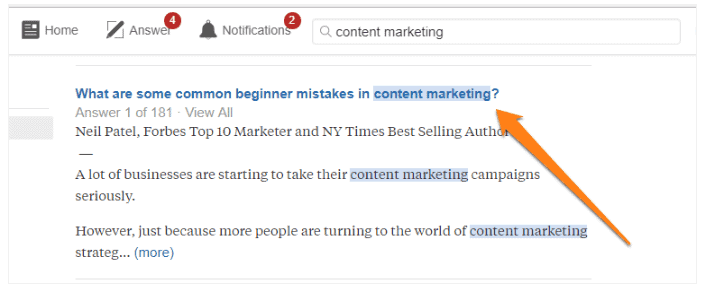
Next, write a detailed answer to the question. Most importantly, include a quote or reference to the influencer you’re trying to target.
For instance, I wanted to reach out to a Venture Beat writer, so I included a quote from her in my answer:
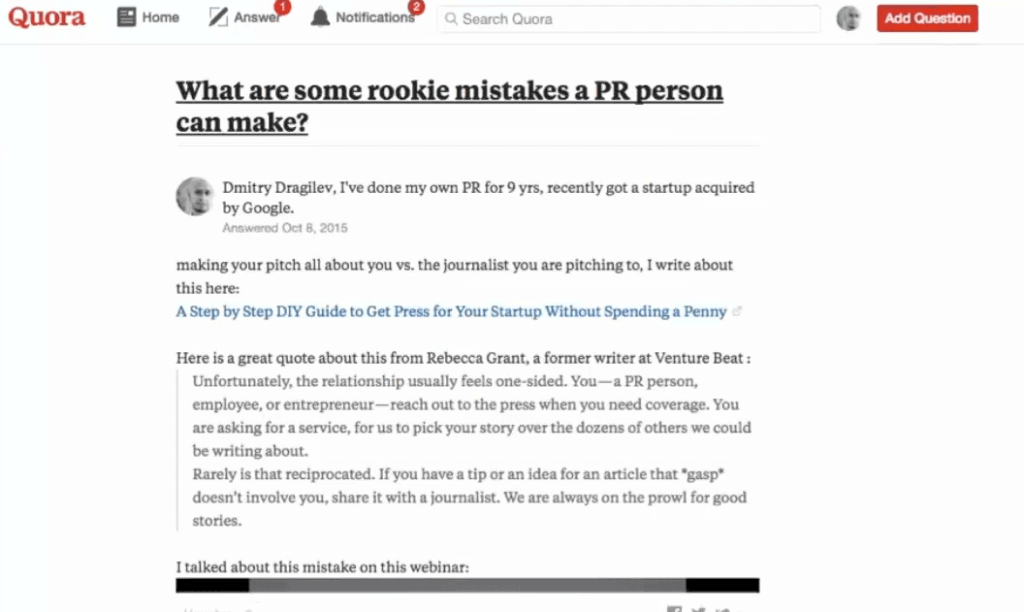
Now reach out to the influencer and tell them about your Quora answer (or a tweet, as in the example below):
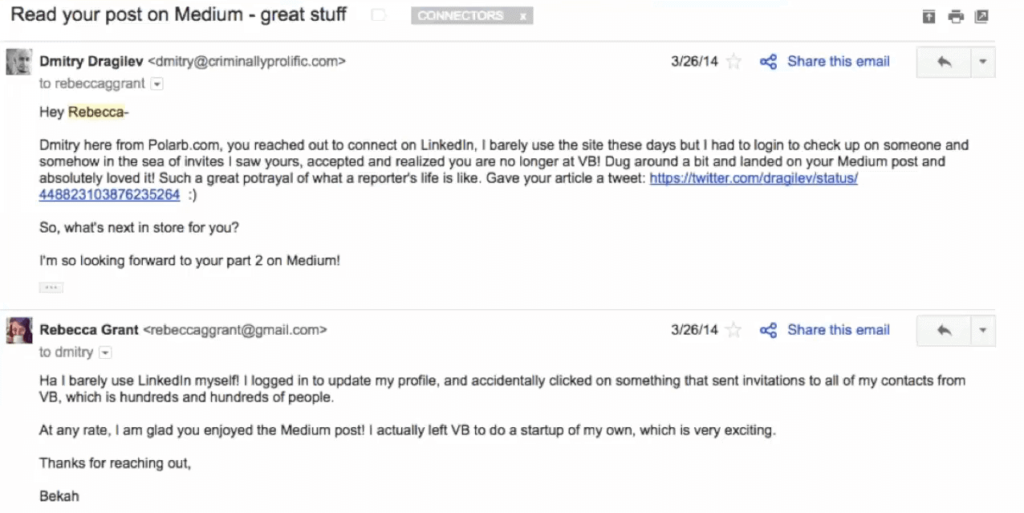
This is an effective tactic to demonstrate that you are genuinely interested in the journalist and his work. By reading their work, improving it, and promoting on a platform that you don’t own, you show your attentiveness, enabling you to form a long-standing relationship.
Here’s a video that gives detailed information on this Quora PR hack:
You can also build your rapport and get the relationship started with your media contact by sharing reports on SaaS trends, white papers, articles on subjects they are interested in to initiate the talk.
Remember: Sending content that is connected to your SaaS business is a big no, no.
Make sure you link to the article you’re mentioning. Providing immediate context to what you’re referring to is always a good idea.
These steps will ensure that your first pitch email will not look like coming from a total stranger. You will have something “personal” to talk about, instead of just asking for a SaaS PR placement.
In his book ‘Behind the Cloud’ Salesforce founder and CEO Marc Benioff emphasizes that building relationships with journalists and bloggers is a pivotal part of this cloud based software company’s marketing strategy.
Benioff has a media list of two dozen reporters whom he considers influential. He is connected with them on social media and maintains good relationships through in-person meetings and frequent contact.
5. Use A Story Angle That Has Worked Before
Some SaaS brands don’t realize it, but you don’t have to create something completely unique and original to get media attention.
You can use a story that has already worked. Just rewrite the narrative to make it relevant to your business.
Here’s an example:
An article was published in Buzzfeed, in June 2014, about an artist who asked people from 25 countries to Photoshop her according to their local beauty standards.
Hundreds of publications picked up that story.
It went viral. The Buzzfeed link itself has over 3.3M views.
Now:
Sometime later, Superdrug borrowed that idea to examine body standards for women in different countries in a story titled “Perceptions of Perfection.”
While Superdrug retained the Buzzfeed post’s main idea, it changed the focus and presentation of its narrative.
This story got a lot of media coverage. It was picked up by over 600 publications and earned over 900,000 shares.
Interestingly, even Buzzfeed picked up the story:
The takeaway for your SaaS business:
- Select an idea that is already working.
- Find ways to make it your own.
3 PR Mistakes To Avoid
Here are a few common mistakes that SaaS brands make, which hurts their PR efforts:
Mistake #1: Hiring a PR Firm With No SaaS Experience
Remember, hiring a dedicated PR firm or PR agency is only the beginning.
If you don’t know whether your expensive big-name PR agency has a proven track record working with SaaS companies, you are writing them a blank cheque.
Before you decide to part with your hard-earned money, ask the PR firm if they have media contacts in publications you want to be featured. Ask them which PR metrics they will measure and how the PR hits will be scored. Push them hard to reveal success stories.
Not every PR firm is capable of getting high-quality PR.
So, you may be wise to do your own PR.
Mistake #2: Not Having a Realistic, Measurable Strategy
This is public relations 101.
If you really want to benefit from a PR campaign, you need to outline a very clear, measurable and realistic PR strategy.
Whether you hire a dedicated PR agency or fly solo, this PR strategy needs to be integrated PR.
Integrated PR is public relations that is closely connected to your marketing efforts.
Your integrated PR strategy should define what you want to achieve with your media coverage.
- Is your PR team telling the right story, in the right places (industry publications, tier 1 media outlets)?
- Will the PR strategy attract the attention of the right people – your prospective customers?
- What PR metrics will you use to measure your PR activity (such as semrush’s insights)?
- What is the cut-off point when you must see results from the PR efforts? (According to Jason Lemkin of SaaStr, you should start seeing results within 60-90 days of initiating a PR strategy.)
It’s even more important to have an integrated PR strategy if your marketing and PR team is going to handle all your PR efforts.
If everything isn’t clearly outlined, monitored, and measured it’s going to be a waste of time and resources.
Remember, you can pump as much money as you want into a PR campaign, but if you don’t know what results you want or when, that PR activity isn’t going to help you.
Mistake #3: Pitching Only to Traditional Media
PR firms generally recommend pitching to traditional media outlets.
However, they shouldn’t be your only option.
Instead of limiting yourself, why not reach out to online SaaS blogs or social media influencers in your niche?
Blogs and influencers are usually:
- Easier to approach
- More reciprocative to highlighting you
- More niche-specific – helping you zero-in on the perfect target audience
I know you want to get mentions on top-tier sites like Forbes, TNW and VentureBeat. But the chances of huge publications giving you a shot right off the bat is pretty low!
You need to start small, and build up from there.
However, don’t underestimate industry blogs and influencers as they can be just as – if not more- effective than the big publications.
After all, why do you think influencer partnerships have such a proven track record? The goodwill your brand can generate through influencer partnerships is immense and it can also add that much needed human element to your b2b marketing.
Why your SaaS company needs PR
Now that you know how you can get some quality PR for your SaaS startup, let’s get into why public relations is so important:
1. You can increase brand awareness
This is one of the key reasons why every company invests in a public relations strategy.
Good PR is one of the easiest ways to gain media coverage and raise brand awareness to attract a potential customer or investor.
Look at it this way:
Your SaaS business is going to have a very limited reach – especially if it’s new. A major publication, on the other hand, reaches thousands (if not millions) of readers or potential customers every day!
What do you think is going to be a better solution to increase brand awareness?
2. You can build credibility
Sure, people may know of your SaaS business – but why should they trust you?
Just because you say so?
That’s never going to work!
However, by gaining media coverage in a reputed publication, your startup can piggyback on that reputation and enhance its own.
There is a type of social proof called credibility by association.
A positive write-up about your startup in an established media outlet will act as that social proof and put you on your target audiences’ radar.
Saas PR: Do It Yourself
PR for SaaS companies is different from public relations for other businesses.
Innovation within the tech industry moves at exponential speed and there’s more industry jargon to reckon with than any other niche.
Therefore, as a SaaS business owner you must either hire a top-notch PR firm that knows exactly what it means to do SaaS PR and has a cracking track record to back that claim, or do-it-yourself.
As a SaaS entrepreneur myself, I believe founders are the best mouthpieces for bagging the best PR mentions.
Ready to run your next SaaS PR campaign?
Let me know your success stories in the comments below.
Hey Dmitry, great post. Quick question: when you say “Come Up With Data/Insights,” what’s the format that a journalist would love. Should I send data as an infographic, or a chart, or plain spreadsheet? Thanks, Romi
Good question Romi. A few things:
1. read this article, I dive deep into example of how to use data to pitch press:
https://readwrite.com/2020/05/08/10-examples-of-how-to-use-data-to-pitch-press-during-covid-19/
2. in terms of an actual pitch, take a look here: https://blog.justreachout.io/media-pitch/
here is a great example of how to do this:
This is a very helpful post. Thanks Dmitry! Are there any resources or articles that could help me learn about PR or public relations strategies in general? Alex
Sure, start with this article below, this breaks down some of my favorite strategies which anyone can pick up and with right effort and dedication get featured: https://www.criminallyprolific.com/media-relations-strategy/
Love your posts! They are always detailed and informative. You have mentioned using Techmeme to source top reporters and media outlets for breaking news. What steps can I use to build an effective media list, if I am not just after reporters who cover breaking news?
Ryan Dean
Sure thing, I wrote an article on how to build media lists not too long ago, not only does it go into how to build a list but also how to start conversations with each prospect on the list, take a look here: https://www.criminallyprolific.com/media-list-examples/
Does this help?
Awesome tactics Dmitry. I was wondering if there are other platforms, apart from HARO and of course JRO that I could access to find media opportunities? Susan
Absolutely Susan, I keep a running list of them here: https://blog.justreachout.io/pr-tools/
Thanks for the tips! If I were to use the Quora PR strategy, how old or new should the question be? Does it matter if the question is more than a year old, but is very relevant to my target journalist? Benjamin K
It doesn’t matter too much Ben. You are just using it to start a conversation with them essentially. Here is a video walk through of how this works: https://justreachout.io/quora-pr-hack
I am a bit skeptical about your Newsjacking tactic. Does it work in every industry? Tech industry is not as exciting or interesting as say the fashion or automobile industry, so my question is how often will I be able to find a viral topic to weave my story into? James H
So you have to really experiment here, it does not work all the time. It’s on case by case basis. What I would do is try different strategies from one of these two posts to see which ones work best for you:
https://www.criminallyprolific.com/media-relations-strategy/
https://www.criminallyprolific.com/marketing-communications-strategy/